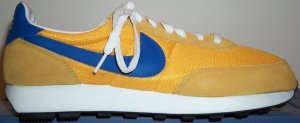
Over the years, Nike has used (to increasing levels) a cushioning technique based on an inert gas encapsulated in polyurethane. US Patent 4219945 covers the basic details of Nike AIR technology.

![]() In the early days, Nike shoes (like this LDV running shoe) did not yet have "Air."
In the early days, Nike shoes (like this LDV running shoe) did not yet have "Air."

![]() Nike then started putting "Air" in their shoes. However, in the Air Force I basketball shoe, they didn't make the fact obvious!
Nike then started putting "Air" in their shoes. However, in the Air Force I basketball shoe, they didn't make the fact obvious!

![]() Nike then started letting people see the "Air" in their shoes, like this Air Afterburner High basketball shoe. US Patent 4817304 describes the reason behind that design change.
Nike then started letting people see the "Air" in their shoes, like this Air Afterburner High basketball shoe. US Patent 4817304 describes the reason behind that design change.

![]() If a little "Air" works, how about putting in a lot, as in this Air Max Triax (1996) running shoe?
If a little "Air" works, how about putting in a lot, as in this Air Max Triax (1996) running shoe?

![]() Now, Nike has gone to having the "Air" in a big bubble at the back, as in the Air Strong High basketball shoe.
Now, Nike has gone to having the "Air" in a big bubble at the back, as in the Air Strong High basketball shoe.

![]() From what Nike states, the Air Strong High has "Air" in both the front and the back, but Nike only showed the "Air" in the back. The Air CB-34 (one of the Charles Barkley Nike shoes), however, shows the "Air" in both the front AND the back. Ideal for those who look like "round mounds of rebound."
From what Nike states, the Air Strong High has "Air" in both the front and the back, but Nike only showed the "Air" in the back. The Air CB-34 (one of the Charles Barkley Nike shoes), however, shows the "Air" in both the front AND the back. Ideal for those who look like "round mounds of rebound."

![]() In the Air Max 2 series, Nike has separated the Air into two compartments to improve the comfort of the shoe.
In the Air Max 2 series, Nike has separated the Air into two compartments to improve the comfort of the shoe.

![]() The Nike Air Max 2 shoe series (as explained by a diagram on the shoe box) incorporates multiple Air chambers. The central Air chamber contains low-pressure Air to provide a cushioned ride. The two side Air chambers contain high-pressure Air, providing additional resistance to rolling motion from side to side. Hard-core runners like Bill insist that it works!
The Nike Air Max 2 shoe series (as explained by a diagram on the shoe box) incorporates multiple Air chambers. The central Air chamber contains low-pressure Air to provide a cushioned ride. The two side Air chambers contain high-pressure Air, providing additional resistance to rolling motion from side to side. Hard-core runners like Bill insist that it works!

![]() The example Air Max Plus running shoe features Tuned Air technology. Tuned Air technology adds hemispherical cup-like structures to Nike Air bubbles. This provides a capability to create a structure of varying stiffness. US Patent 5572804 covers the design of the cushioning structures.
The example Air Max Plus running shoe features Tuned Air technology. Tuned Air technology adds hemispherical cup-like structures to Nike Air bubbles. This provides a capability to create a structure of varying stiffness. US Patent 5572804 covers the design of the cushioning structures.
![]() Back to the top of Charlie's Sneaker Pages!
Back to the top of Charlie's Sneaker Pages!
Last Updated: 24 February 2017
Click here to send E-mail to Charlie.
Charlie's Sneaker Pages copyright 1995-2024 by Charles L. Perrin.
READERS PLEASE NOTE: Names of athletic shoe manufacturers, shoe styles, and technologies may be trademarked by the manufacturers. Charlie's Sneaker Pages uses these names solely to describe the shoes with the same familiar nomenclature used by the manufacturer and recognized by the reader.